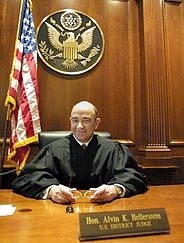Having failed to budge the courts from the strict liability long imposed on contractors when workers fall from heights, New York's construction industry has mounted a major campaign to reduce verdicts by imposing "comparative negligence" on workers who suffer injury. Workers are in fact often careless. That's a fact of life. So the law has sought to compel employers and and owners to protect workers from their own failings. But with typical sky is falling rhetoric the industry seeks relief from the
that has seen Manhattan grow ever higher and dense despite the liability burden. - GWC
In 1885, as new engineering inventions were ushering in the era of the skyscraper, lawmakers in New York State
enacted a lawintended to safeguard construction workers who were finding themselves facing increasing dangers while working at ever-greater heights.
Michael Appleton for The New York Times
A construction worker standing on scaffolding on Greenwich Avenue. A counter-lobby of unions, worker’s advocates and trial lawyers is pushing back to preserve the law.
That measure, which became known as the Scaffold Law, required employers on building sites to ensure the safety of laborers working above the ground. Since then, some form of the legislation has remained on the books despite repeated attempts to repeal it.
But a lobby of contractors, property owners and insurers has in recent months renewed a campaign against the law, arguing that no less than the future of the state’s construction industry is at stake.
They argue that
the law is antiquated and prejudicial against contractors and property owners, and essentially absolves employees of responsibility for their own accidents, leading to astronomical settlements. The payouts, they contend, have in turn led to skyrocketing insurance premiums that are hampering construction and the state’s economic growth.
On Tuesday, a
coalition of contractors, including a newly formed alliance of firms owned by women and minorities, announced the start of an advertising and lobbying blitz in Albany and New York City. But a counter-lobby of unions, worker’s advocates and trial lawyers is pushing back just as fiercely. The law, they argue, is essential to ensuring the safety of workers in some of the world’s most dangerous jobs, particularly those employed by shoddy contracting firms that cut corners to save money. The law, they say, holds developers and contractors accountable for keeping job sites safe.
Gov. Andrew M. Cuomo, on Monday, acknowledged the politically loaded atmosphere surrounding the Scaffold Law, but suggested that he was open to the possibility of modifying the law.
The law states that contractors and property owners are responsible for ensuring that scaffolds, hoists and other devices that enable above ground building construction and repair “shall be constructed, placed and operated as to give proper protection to a person so employed.”
When injuries result from a violation of those terms, the law says, contractors and owners are liable. There is no mention of worker responsibility. Under the law, however, the plaintiff still must show that a violation of the law’s standards occurred and that the violation caused the injury.
But those seeking to change the law want to incorporate a standard of “comparative negligence.” This amendment — described in a
state bill submitted earlier this year — would require a jury or arbiter to consider whether the liability of the defendants — and thus the amount of damages — should be reduced for cases in which the worker’s negligence or failure to follow safety procedures contributed to the accident.


 Much remains unknown about the proposed settlement in the NFL Concussion Litigation. The agreement has not been filed, but there is some information online. See
Much remains unknown about the proposed settlement in the NFL Concussion Litigation. The agreement has not been filed, but there is some information online. See 







